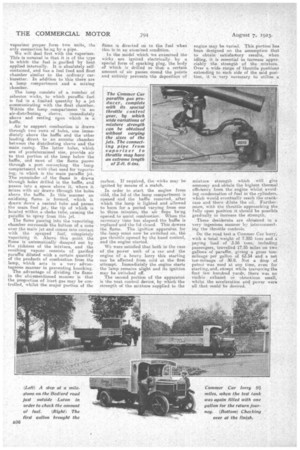THE LATEST IN PARAFFIN GAS PRODUCERS.
Page 19

Page 20

If you've noticed an error in this article please click here to report it so we can fix it.
Details of a Successful Device in which Heat is Applied Internally, and Conclusions Drawn from a Road Trial.
LAST:WEEK we gave brief particulars of the remarkably simple and efficient paraffin vaporizing device which has just been-perfeeted, after many years of eiLperiment,' by Commercial Cars, Ltd., of 'Allen. The makers are satisfied that they have developed an instrument which will overcome the majority. if not all, of the troubles which have previously debarred the paraffibi vaporizer from becoming a really successful proposition, and one which could be applied to any make of vehicle oragrimotor, and used with the same facility as the ordinary petrol carburetter.
After seeing the behaviour of the instrument in starting direct from cold on. paraffin and on a fairly long road test which included severe hills, we are inclined to the belief that the Makers have not exaggerated their claims.
One of the most remarkable features about the Commer Car gas producer is its size, which is little more than that of an ordinary • carburetter. Actually the throttle and air contrOl ar'd the vaporizer proper form two units, the only connection being by a. pipe.
We will deal first with the vapori-zer. This is unusual in that it is of the type in -which the fuel is,gasified by heat applied internally. It is absolutely selfcontained, and has a fuel feed and float chamber similar to the ordinary carburetter.. In addition to this there are a -lamp compartment and a mixing
chamber. .
The lamp consists of a number of asbestos wicks, to which paraffin fuel is fed in a limited quantity by a jet communicating with the float eharriber. Within the lamp compartment 'is an air-distributing sleeve, immediately above and resting upon which is a. baffle.
Air to support combustion is drawn through two rows of holes, one immediately above the baffle and the other leading direct to an annular chamber between the distributing sleeve and the main casing. The latter holes, which are of predetermined size, provide air to that portion of the lamp below the bailie, and most of the flame passes through a port connecting the lamp compartment with that used for vaporizing, in which is the main paraffin jet. The remainder of the flame is drawn through holes drilled in the baffle, and passes into a space above it, where it mixes with air drawn through the holes above the baffle. In this manner an oxidizing. flame is formed, which is drawn' down a Central tube and passes the main, fuel jet, the tip of 'winch is located within. a choke tube, causing the paraffin' to 'spray from this jet. The flame passing into the vaporieing chamber surrounds the bettom of a cone over the main jet and comes into contact with the -sprayed . fuel; completely vaporizing it. Above this . point the flame is automatically damped out by the richness of the mixture, and the resulting vapour consists of gasified paraffin diluted with a certain quantity of the products of combustion from the lamp, which ants in a very advantageous manner in preventing knocking.
The advantage of dividing, the flame in the aforementioned manner is that the proportion of inert gas may be controlled, whilst the major portion of the flame is directed on to the fuel when this is in att atomized condition.
En the model which we examined the wicks are ignited electrically by a special form of sparking plug, the body of which is drilled so that a certain amount of air passes round the points and entirely prevents the deposition of carbon. If required, the wicks may be ignited by means of a match.
In order to start the engine from cold, the lid of, the lamp compartment is opened and the baffle removed, after which the lamp is lighted and allowed to burn for a period varying from one to three minutes, the air flaps hang opened. to assist combustion. When the necessary time has elapsed, the baffle is replaced and the lid closed. This dowses the flame. The ignition apparatus for the lamp must now be switched on, the gas throttle opened by the hand control, and the engine started.
We were satisfied that both in the case of , the power unit of a car and the engine of a heavy lorry this starting can be effected from cold at the first attempt. Immediately the engine starts the lamp remains alight and its ignition may be switched off.
The second portion of the apparatus is the neat control device, by which the strength of the mixture supplied to the
engine may be varied. This portion has been designed on the assumption that to obtain satisfactory results, when idling, it is essential to increase appreciably the strength of the mixture. Over a wide range of throttle positions extending to each side of the mid position, it -is very necessary to utilize a
mixture • strength which will give economy and obtain the highest thermal efficiency from the engine whilst avoiding condensation of .fuel in the cylinders, which Would eventually reach the crankcase and there dilute the oil. Furthermore, with the throttle approaching the fully open position it should be possible gradually to increase the strength.
These desiderata are obtained in a very ingenious nianner by interconnecting the throttle controls.
On the road test a Commer Car lorry, with a total weight of 7.325 tons and a paying lead of 3.55 tons, including passengers, travelled 17.5 miles on two gallons of paraffin, :giving a gross tonmileaga per gallon of 63.54 and a net ton-mileage of 30.8.Not a drop of petrol was used at any time, even for starting, and, otoept while travers:ng the -first few hundred yards, there was no visible exhaust or obnoxious smell, whilst tho acceleration and power were all that couldbe desired.




























